Underwater optical environment in the coastal waters of British Columbia, Canada
Abstract
Introduction
Materials and methods
Study area
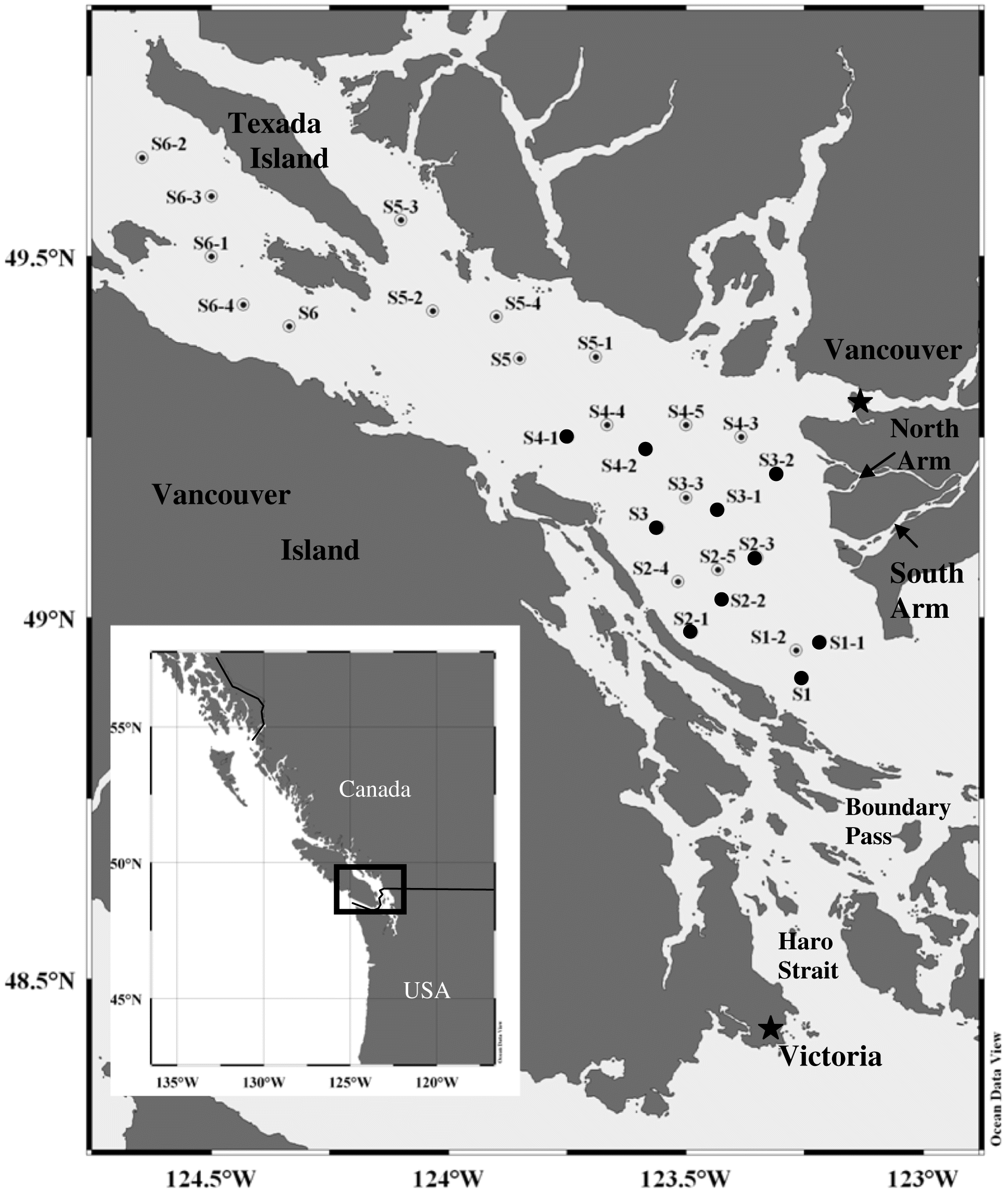
Data collection
Modelling
HydroLight radiative transfer modelling
| 411 nm | 530 nm | 650 nm | 675 nm | |||||||||||||
|---|---|---|---|---|---|---|---|---|---|---|---|---|---|---|---|---|
| April | July | April | July | April | July | April | July | |||||||||
| r 2 | Slope | r 2 | Slope | r 2 | Slope | r 2 | Slope | r 2 | Slope | r 2 | Slope | r 2 | Slope | r 2 | Slope | |
| Ed (0−,λ) | 0.79 | 1.41 | 0.91 | 1.17 | 0.72 | 1.27 | 0.92 | 1.06 | 0.90 | 1.40 | 0.90 | 1.05 | 0.90 | 1.42 | 0.89 | 1.03 |
| Lu (0−,λ) | 0.76 | 1.32 | 0.81 | 1.25 | 0.71 | 1.35 | 0.81 | 1.19 | 0.92 | 1.24 | 0.96 | 1.74 | 0.85 | 1.20 | 0.96 | 1.72 |
| K Ed(0−,λ) | 0.79 | 0.78 | 0.74 | 0.84 | 0.85 | 0.64 | 0.79 | 0.61 | 0.72 | 0.40 | 0.79 | 0.43 | 0.64 | 0.36 | 0.69 | 0.35 |
| Rr (0−,λ) | 0.46 | 0.40 | 0.36 | 0.27 | 0.81 | 0.99 | 0.90 | 0.71 | 0.90 | 0.90 | 0.88 | 0.88 | 0.60 | 0.84 | 0.71 | 0.73 |
Note: Ed (z,λ), spectral downwelling plane irradiance; Lu (z,λ), spectral upwelling radiance; K Ed(z,λ) downwelling irradiance attenuation coefficient; Rr (z,λ), underwater radiance reflectance; 0–, in the water.
Results and discussion
Hydrographic data and water optical constituents
Optical dynamics
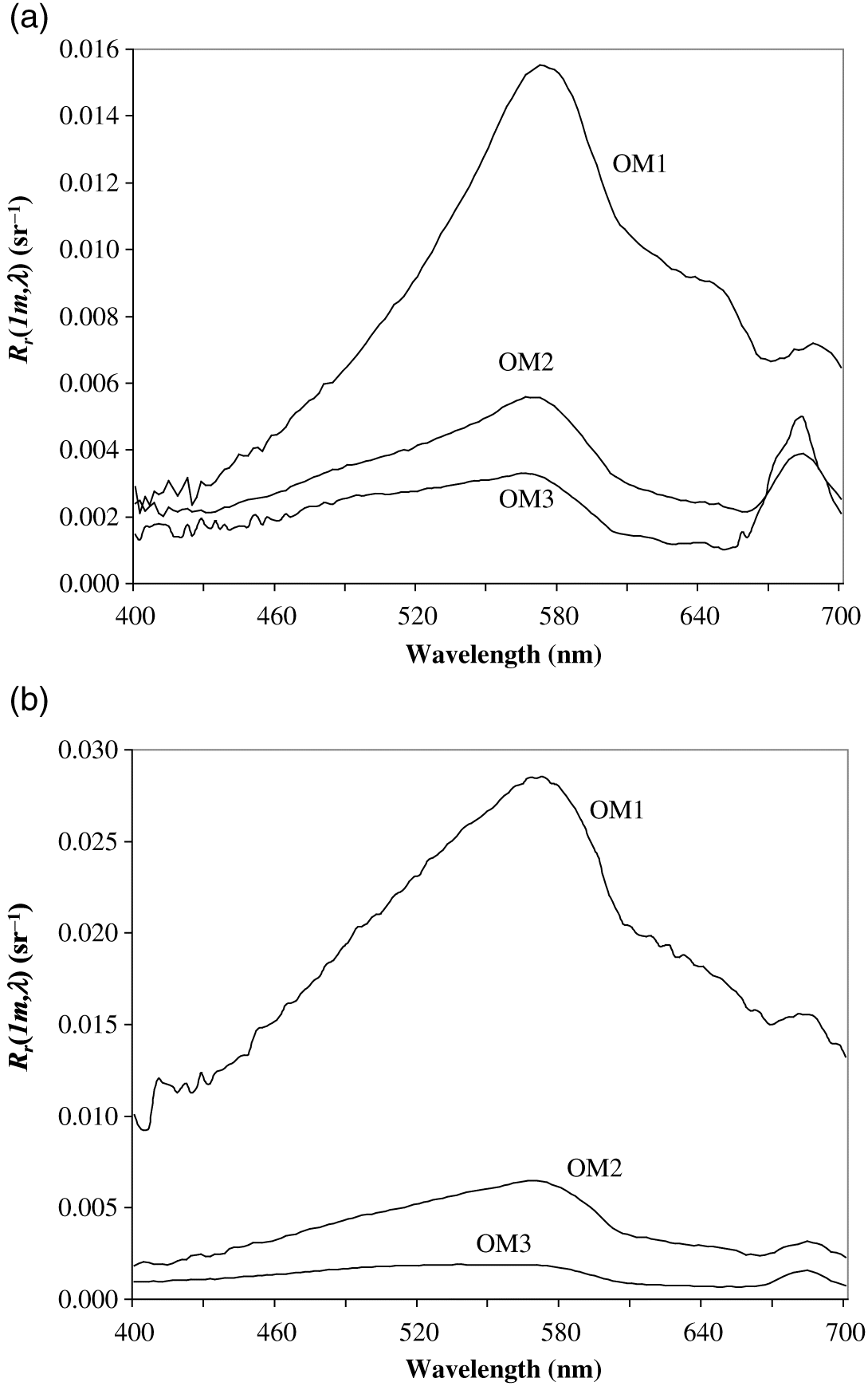
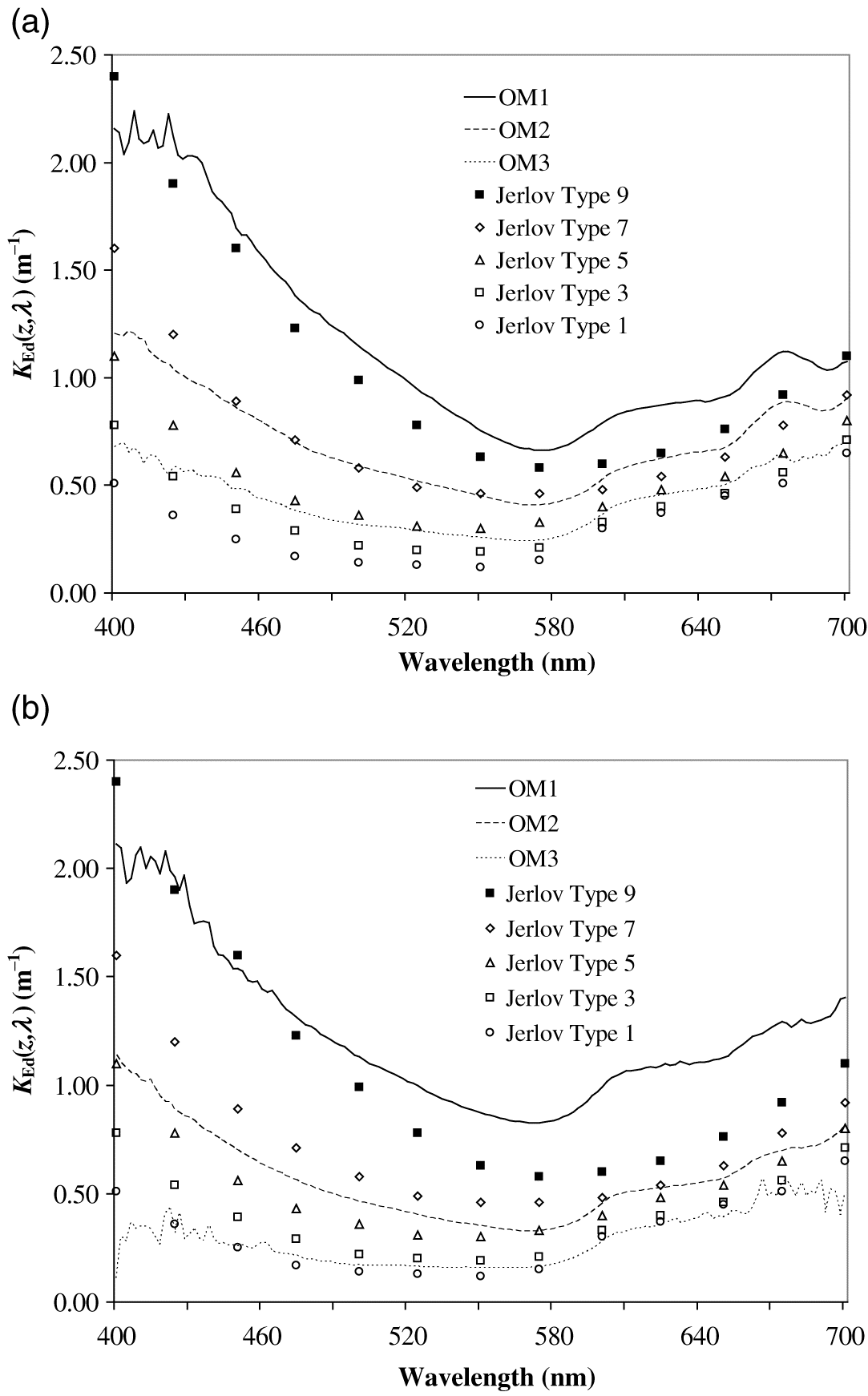
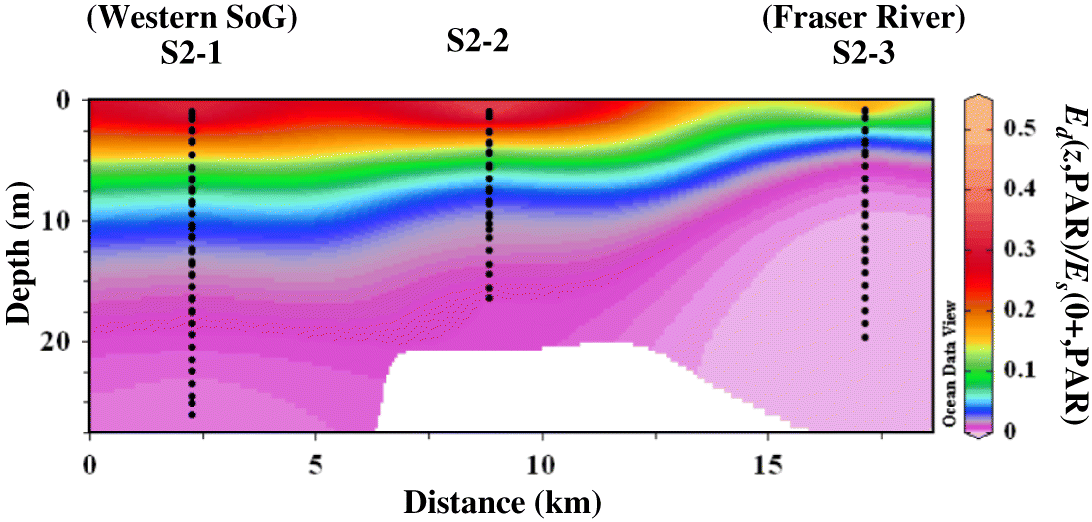
Scalar irradiance and the average cosine
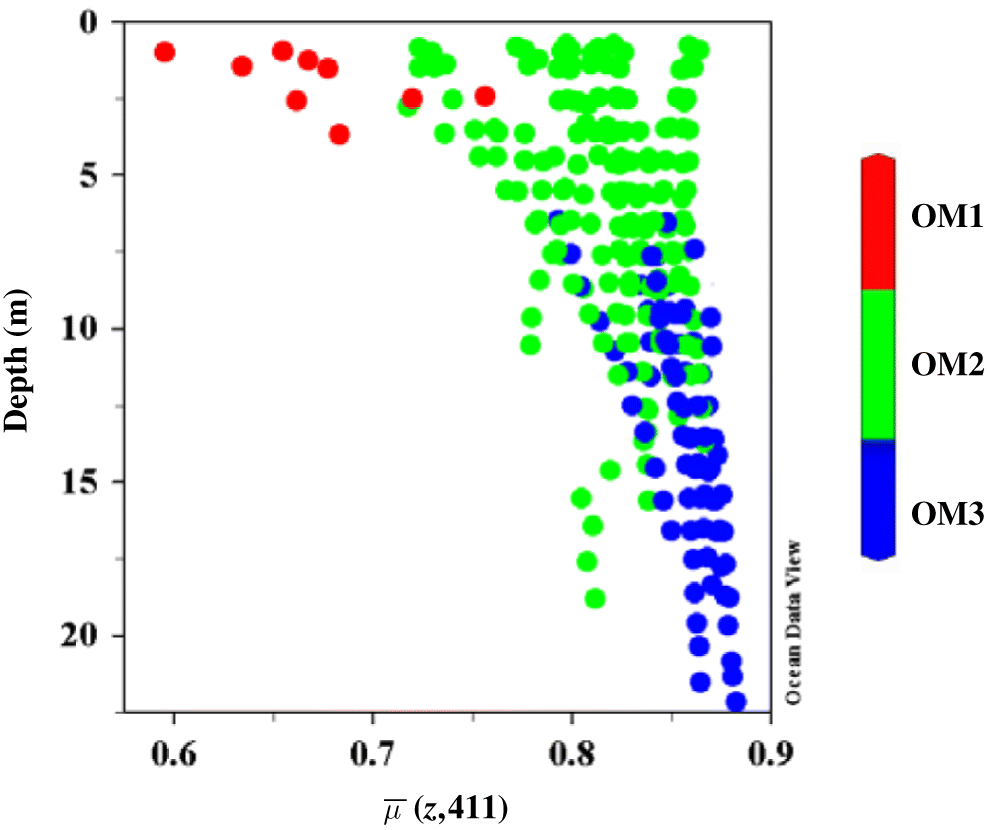
| Optical water mass | 411 nm | 530 nm | 650 nm | 675 nm | |||||
|---|---|---|---|---|---|---|---|---|---|
| April | July | April | July | April | July | April | July | ||
| (z,λ) | OM1 | 0.77 ± 0.03 | 0.67 ± 0.05 | 0.61 ± 0.03 | 0.52 ± 0.06 | 0.62 ± 0.05 | 0.55 ± 0.09 | 0.66 ± 0.05 | 0.57 ± 0.10 |
| OM2 | 0.81 ± 0.04 | 0.82 ± 0.03 | 0.71 ± 0.06 | 0.74 ± 0.05 | 0.78 ± 0.05 | 0.80 ± 0.05 | 0.73 ± 0.07 | 0.75 ± 0.07 | |
| OM3 | 0.85 ± 0.02 | 0.90 ± 0.02 | 0.76 ± 0.04 | 0.78 ± 0.04 | 0.84 ± 0.03 | 0.85 ± 0.03 | 0.64 ± 0.14 | 0.63 ± 0.16 | |
| Ed (0−,λ) (× 102) (W·m−2·nm−1) | OM1 | 0.91 ± 1.83 | 2.19 ± 3.27 | 8.55 ± 8.00 | 14.57 ± 11.30 | 7.00 ± 6.10 | 10.24 ± 8.13 | 5.26 ± 5.52 | 8.28 ± 7.56 |
| OM2 | 1.96 ± 3.51 | 3.44 ± 8.51 | 17.76 ± 14.04 | 19.18 ± 23.15 | 6.75 ± 8.25 | 8.23 ± 13.96 | 3.70 ± 5.38 | 5.75 ± 11.49 | |
| OM3 | 0.67 ± 2.16 | 0.02 ± 0.04 | 7.04 ± 6.30 | 4.40 ± 3.82 | 1.44 ± 3.04 | 0.21 ± 0.32 | 0.85 ± 2.45 | 0.06 ± 0.10 | |
| Lu (0−,λ) (× 102) (W·m−2·sr−1·nm−1) | OM1 | 0.002 ± 0.005 | 0.015 ± 0.024 | 0.078 ± 0.082 | 0.25 ± 0.26 | 0.058 ± 0.066 | 0.17 ± 0.23 | 0.037 ± 0.048 | 0.13 ± 0.18 |
| OM2 | 0.003 ± 0.005 | 0.005 ± 0.011 | 0.074 ± 0.078 | 0.059 ± 0.070 | 0.013 ± 0.0.22 | 0.013 ± 0.025 | 0.016 ± 0.020 | 0.015 ± 0.024 | |
| OM3 | 0.001 ± 0.002 | 3.53 × 10−5 ± 5.99 × 10−5 | 0.023 ± 0.026 | 0.010 ± 0.007 | 0.001 ± 0.003 | 2.19 × 10−4 ± 2.49 × 10−4 | 0.003 ± 0.005 | 6.54 × 10−4 ± 6.26 × 10−4 | |
| K Ed(0−,λ) (m−1) | OM1 | 2.28 ± 0.52 | 2.01 ± 0.67 | 0.69 ± 0.14 | 0.84 ± 0.35 | 0.68 ± 0.06 | 0.87 ± 0.22 | 0.87 ± 0.06 | 1.01 ± 0.19 |
| OM2 | 0.75 ± 0.22 | 0.73 ± 0.27 | 0.26 ± 0.08 | 0.26 ± 0.10 | 0.52 ± 0.07 | 0.49 ± 0.06 | 0.69 ± 0.13 | 0.61 ± 0.09 | |
| OM3 | 0.48 ± 0.09 | 0.43 ± 0.10 | 0.15 ± 0.03 | 0.15 ± 0.03 | 0.42 ± 0.02 | 0.42 ± 0.02 | 0.48 ± 0.11 | 0.45 ± 0.10 | |
| Rr (0−,λ) (× 103) (sr−1) | OM1 | 2.00 ± 0.51 | 6.00 ± 2.00 | 8.00 ± 2.00 | 17.00 ± 7.00 | 7.00 ± 3.00 | 15.00 ± 10.00 | 6.00 ± 2.00 | 13.00 ± 8.00 |
| OM2 | 1.58 ± 0.58 | 1.70 ± 0.60 | 4.00 ± 1.95 | 4.00 ± 3.00 | 1.53 ± 0.83 | 1.78 ± 1.78 | 9.00 ± 10.00 | 8.00 ± 9.00 | |
| OM3 | 1.40 ± 0.29 | 1.45 ± 0.42 | 3.00 ± 1.00 | 2.00 ± 1.44 | 1.60 ± 1.15 | 1.83 ± 1.66 | 28.00 ± 27.00 | 29.00 ± 28.00 | |
| bb′(z,λ) (m−1) | OM1 | 0.041 ± 0.015 | 0.091 ± 0.050 | 0.038 ± 0.015 | 0.088 ± 0.052 | 0.036 ± 0.014 | 0.083 ± 0.052 | 0.035 ± 0.015 | 0.082 ± 0.053 |
| OM2 | 0.007 ± 0.005 | 0.008 ± 0.006 | 0.008 ± 0.005 | 0.007 ± 0.006 | 0.007 ± 0.005 | 0.007 ± 0.006 | 0.006 ± 0.005 | 0.006 ± 0.005 | |
| OM3 | 0.002 ± 0.001 | 0.002 ± 0.002 | 0.003 ± 0.002 | 0.002 ± 0.001 | 0.002 ± 0.002 | 0.002 ± 0.001 | 0.002 ± 0.001 | 0.002 ± 0.001 | |
| bb′(z,λ)/bp′(z,λ) | OM1 | 0.010 ± 0.003 | 0.014 ± 0.006 | 0.010 ± 0.003 | 0.014 ± 0.007 | 0.010 ± 0.003 | 0.014 ± 0.007 | 0.010 ± 0.003 | 0.014 ± 0.007 |
| OM2 | 0.009 ± 0.005 | 0.012 ± 0.006 | 0.009 ± 0.005 | 0.012 ± 0.007 | 0.009 ± 0.005 | 0.012 ± 0.007 | 0.009 ± 0.005 | 0.012 ± 0.007 | |
| OM3 | 0.008 ± 0.004 | 0.011 ± 0.007 | 0.008 ± 0.004 | 0.011 ± 0.007 | 0.008 ± 0.004 | 0.011 ± 0.007 | 0.008 ± 0.004 | 0.011 ± 0.007 | |
| nEo (0−,λ) | OM1 | 0.016 ± 0.031 | 0.029 ± 0.047 | 0.154 ± 0.141 | 0.216 ± 0.180 | 0.159 ± 0.141 | 0.152 ± 0.130 | 0.113 ± 0.121 | 0.117 ± 0.114 |
| OM2 | 0.021 ± 0.036 | 0.031 ± 0.064 | 0.172 ± 0.111 | 0.152 ± 0.137 | 0.071 ± 0.076 | 0.079 ± 0.110 | 0.039 ± 0.051 | 0.055 ± 0.091 | |
| OM3 | 0.014 ± 0.042 | 0.000 ± 0.001 | 0.120 ± 0.106 | 0.036 ± 0.022 | 0.029 ± 0.062 | 0.002 ± 0.003 | 0.018 ± 0.049 | 0.001 ± 0.001 | |
Note: (z,λ), average cosine of downwelling irradiance; Ed (z,λ), spectral downwelling plane irradiance; Lu (z,λ), spectral upwelling radiance; K Ed(z,λ) downwelling irradiance attenuation coefficient; Rr (z,λ), underwater radiance reflectance; bb′(z,λ), particulate backscattering; bp′(z,λ) particulate scattering; nEo (z,λ), normalized scalar irradiance; 0–, in the water.
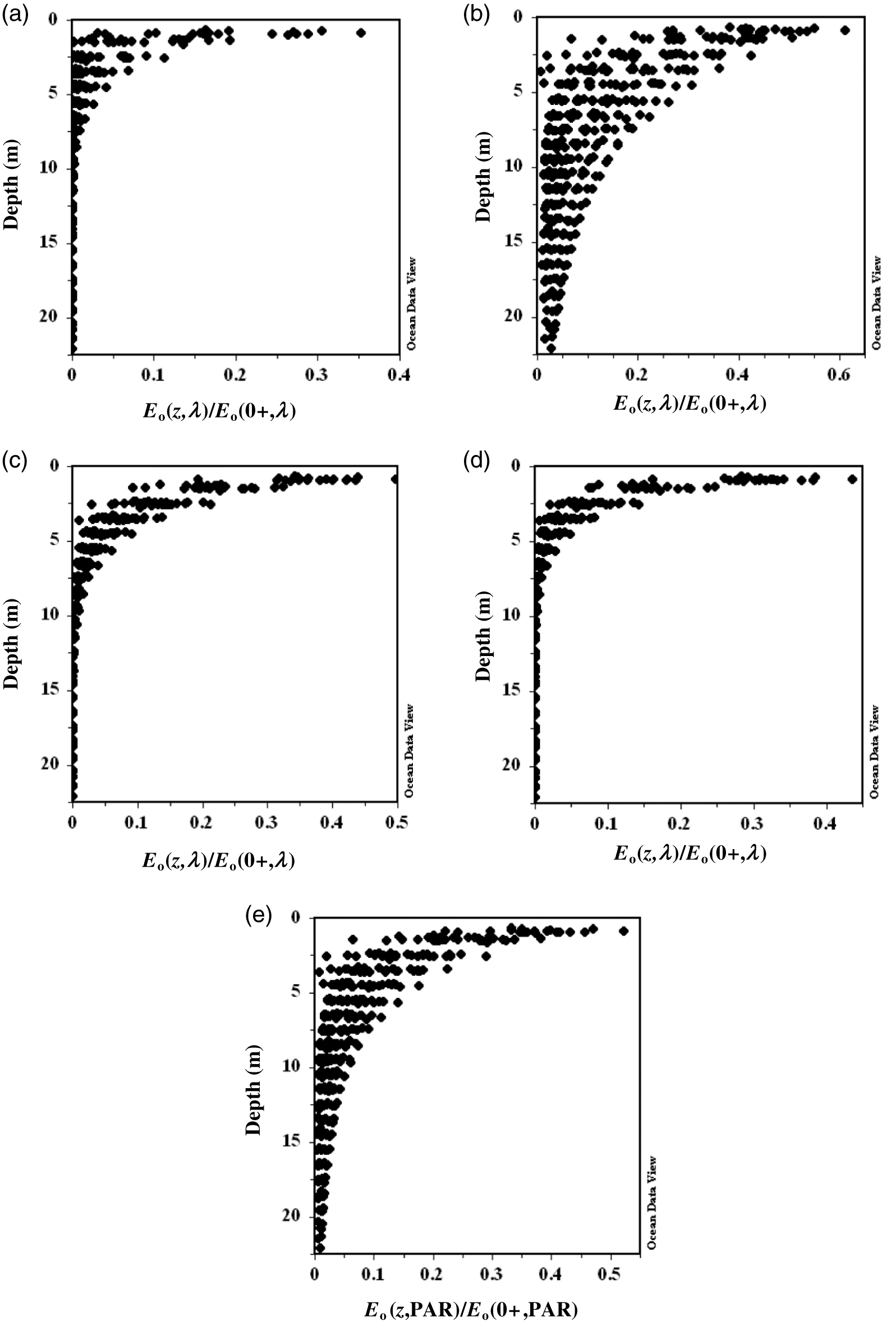
| Month | Station | Modelled K Eo(z,PAR) (mean) (m−1) | Modelled K Ed(0−,PAR) (mean) (m−1) |
|---|---|---|---|
| April | S1-1 | 0.361 | 0.356 |
| S1 | 0.288 | 0.288 | |
| S2-1 | 0.169 | 0.169 | |
| S2-2 | 0.240 | 0.245 | |
| S2-3 | 0.998 | 0.963 | |
| S3 | 0.181 | 0.182 | |
| S3-1 | 0.260 | 0.256 | |
| S3-2 | 0.658 | 0.653 | |
| S4-1 | 0.221 | 0.220 | |
| S4-2 | 0.337 | 0.338 | |
| S4-3 | 0.478 | 0.491 | |
| July | S1-1 | 0.306 | 0.308 |
| S1-2 | 0.254 | 0.253 | |
| S1 | 0.232 | 0.232 | |
| S2-1 | 0.286 | 0.291 | |
| S2-2 | 0.400 | 0.400 | |
| S2-3 | 1.957 | 1.900 | |
| S3 | 0.358 | 0.333 | |
| S3-1 | 0.563 | 0.565 | |
| S3-2 | 0.648 | 0.618 | |
| S3-3 | 0.393 | 0.388 | |
| S4-1 | 0.211 | 0.213 | |
| S4-2 | 0.412 | 0.415 | |
| S4-3 | 0.473 | 0.475 | |
| S5 | 0.381 | 0.387 | |
| S5-1 | 0.264 | 0.268 | |
| S5-2 | 0.442 | 0.441 | |
| S6 | 0.255 | 0.257 | |
| S6-1 | 0.237 | 0.237 | |
| S6-2 | 0.283 | 0.279 |
Note: K Eo(z,PAR), scalar irradiance attenuation coefficient; K Ed(0−,PAR), downwelling irradiance attenuation coefficient; PAR, photosynthetically available radiation, 0–, in the water.
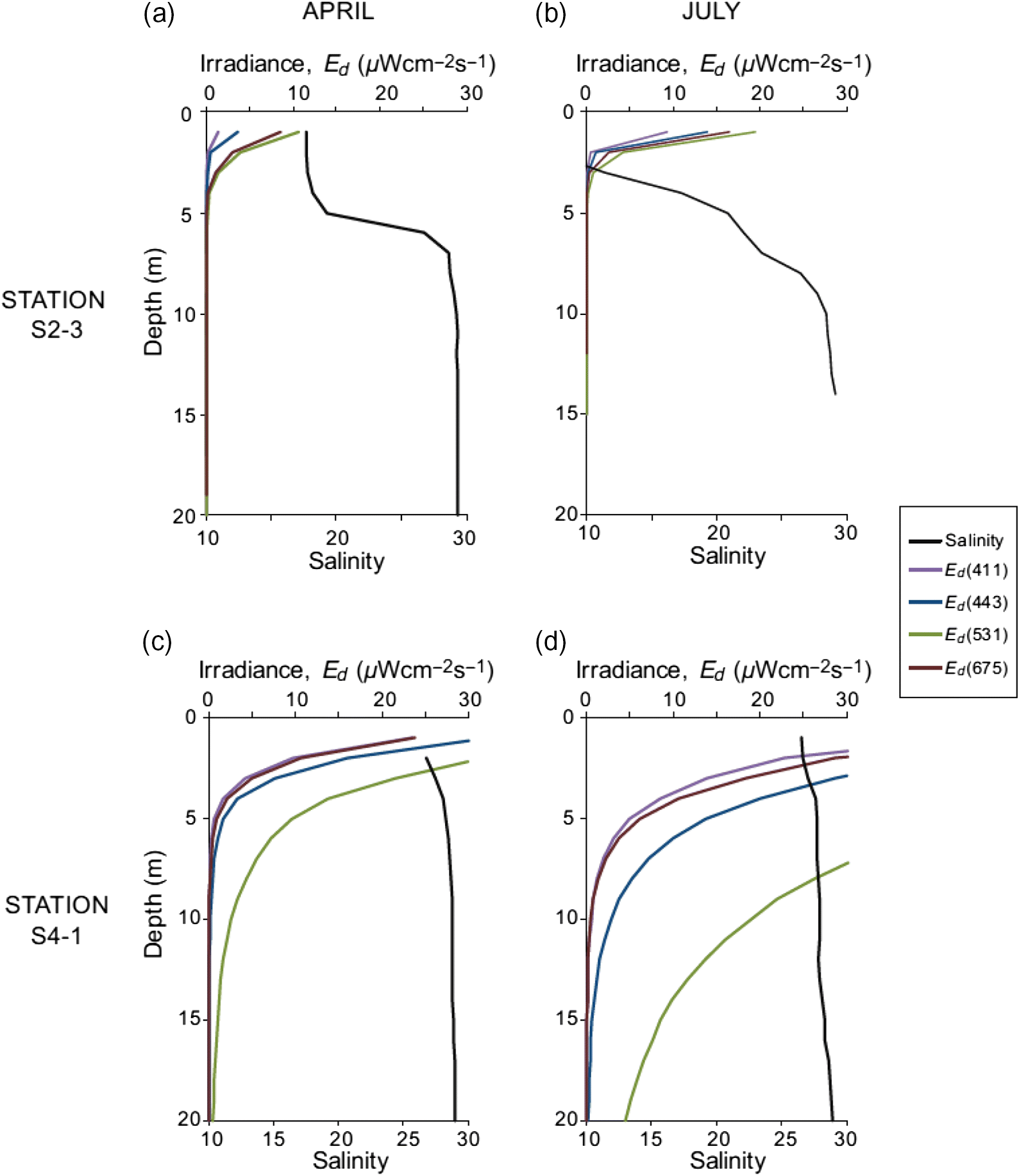
Conclusions
List of abbreviations
- AOP
- apparent optical property
- CDOM
- chromophoric dissolved organic matter
- chl a
- chlorophyll a
- FF
- Fournier-Forand
- HPLC
- high-performance liquid chromatography
- IOP
- inherent optical property
- Minispec OCR
- miniature hyperspectral ocean colour radiometer
- MSV
- Marine Science Vessel
- OM
- optical water mass
- PAR
- photosynthetically available radiation
- SoG
- Strait of Georgia
- SD
- standard deviation
Fundamental quantities and other symbols
- 0+
- above water
- 0−
- in the water column
- B wd
- wavelength-dependence of the backscattering coefficient
- p
- probability value
- r 2
- coefficient of determination
- λ
- wavelength (nm)
- z
- depth (m)
- Z 1%
- depth of 1% irradiance (m)
- Z eu
- depth of the euphotic zone (m)
Radiometric quantities
- Lu
- upwelling radiance (W·m−2·sr−1)
- Lw
- water-leaving radiance (W·m−2·sr−1)
- Ed
- in-water downwelling irradiance (W·m−2)
- Es
- above-water downwelling irradiance (W·m−2)
- Eu
- above-water downwelling irradiance (W·m−2)
- Eo
- scalar irradiance (W·m−2)
- nEo
- modelled normalized scalar irradiance (W·m−2)
Inherent optical properties
- a t′
- scattering-corrected absorption coefficient (m−1)
- a c′
- scattering-corrected CDOM absorption coefficient (m−1)
- b t′
- total scattering coefficient without water scattering coefficient (m−1)
- b p′
- particulate scattering coefficient without water scattering coefficient (m−1)
- b b′
- modelled particulate backscattering coefficient (m−1)
- c t′
- measured total beam attenuation coefficient without water beam attenuation coefficient (m−1)
Apparent optical properties
- Rr
- radiance reflectance (sr−1)
- K Ed
- downwelling irradiance attenuation coefficient (m−1)
- K Eo
- scalar irradiance attenuation coefficient (m−1)
- average cosine
Acknowledgements
References
Information & Authors
Information
Published In

History
Copyright
Data Availability Statement
Key Words
Sections
Subjects
Authors
Author Contributions
Competing Interests
Metrics & Citations
Metrics
Other Metrics
Citations
Cite As
Export Citations
If you have the appropriate software installed, you can download article citation data to the citation manager of your choice. Simply select your manager software from the list below and click Download.
